
© Foteini Christofilopoulou, courtesy the Royal Opera House. (Click image for larger version)
Royal Ballet
Onegin
London, Royal Opera House
24 January 2015
Gallery of pictures by Foteini Christofilopoulou
www.roh.org.uk
It is somewhat fortuitous that the current run of the Royal Ballet’s Onegin opened two days after what would have been George Balanchine’s one hundred-eleventh birthday. As we are reminded in Horst Koeger’s programme note, Balanchine’s views on John Cranko’s 1965 masterwork were damning. Enraged by what he believed to be a betrayal of both Pushkin’s narrative and Tchaikovsky’s music, he called for John Cranko and the whole creative team to be jailed for such an offence to Russian culture.

© Foteini Christofilopoulou, courtesy the Royal Opera House. (Click image for larger version)
Luckily, not everyone was of the same opinion and Onegin remains a sparkling example of what a narrative ballet is and ought to be. Indeed it is the way drama is so carefully woven in the choreographic text that allows the work to renew itself through time, for the interpretative possibilities it offers are endless. Every step has meaning. Look, for instance, at the way the two great duets between the two protagonists are constructed. In the first, the dream vision of Onegin constantly pulls Tatiana towards him through a number of choreographic solutions that are but variations on a theme. His embraces are indeed passionate and the drive of the lifting motions that punctuate the whole duet encapsulates the young girl’s burning love. Yet, some of the more daredevil acrobatics hint at a not-so-happy ending, as nothing is choreographically linear and simple; Onegin’s pulling motions rest on a combination of entangled arms, uneasy angles, sudden jerks and somewhat violent solutions, which leave little doubt as to what is to come. Likewise, at the beginning of the final duet, the now-matured heroine repeatedly moves away from the desperate clutches of the floor-bound Onegin. He tries to pull her back, but she moves inexorably forward, as if to remind him that she is intending to move forward with her life, even though under the burden of heartbreaking memories.
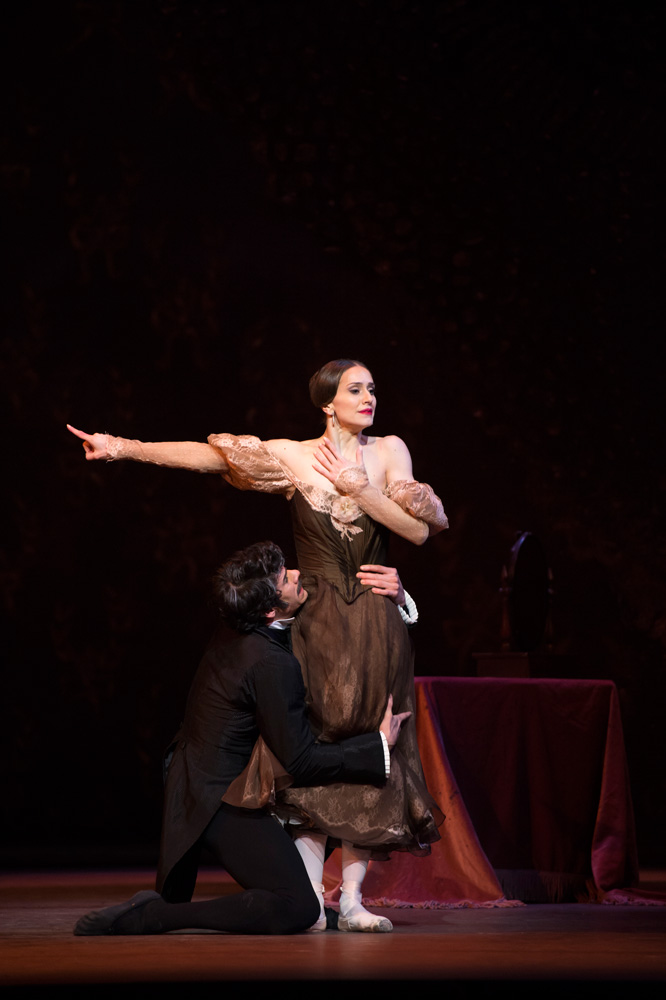
© Bill Cooper Photograph. © 2013 The Royal Opera House / Bill Cooper. (Click image for larger version)
It is in the light of such a drama-laden choreographic text that any attempt at subverting the dancing with the usual trick of the trade favoured by modern-day ballet teachers and directors – hyperextended legs, unbearably sustained legatos that wash away any shading or contrast, unashamed evidence of preparation etc. – detracts greatly from a successful rendition of the work. Luckily, the Royal Ballet has a roster of stars who understand ballet to be first and foremost a ‘theatre’ art. In 2013 Marianela Nuñez and Thiago Soares received unanimous acclaim as the ballet’s incandescent protagonists. Two years down the line, they are still stellar and not just because their technical dancing is sheer perfection. In Saturday’s performance, Nuñez, cogently highlighted the heroine’s shyness and built the whole drama around it. Her Tatiana is not just an asocial bookworm, but someone who takes refuge behind the cover of a book because she does not feel confident to interact with the rest of the world. The outcome of such reading is breathtaking and bestows vibrancy to all the ensuing actions; the moment she succumbs to her curiosity and gets frightened by Onegin’s reflection in the mirror, becomes key to the whole drama. It is with the same mix of shyness and curiosity that she will later approach the bigger mirror in her bedroom; and dramatically powerful echoes of that same shyness are also seen at the end, when she struggles not to succumb to his desperate pleas.

© Foteini Christofilopoulou, courtesy the Royal Opera House. (Click image for larger version)
Soares too is a great dancer/actor. Onegin is not an easy role, for it can sleazily be turned into a two-dimensional villain who enjoys being negative for the sheer sake of being negative. With Soares, the character acquires a wealth of depths and shadings, which turn his Onegin into the quintessential representation of that lack of satisfaction the Romantics indulged in, even to extreme consequences. His emotional collapse, immediately after the duel, is another pivotal moment in the narrative; a moment that Soares took full ownership of, as few before him ever did. His calibrated romantic darkness was superbly matched by Vadim Muntagirov’s youthfully ebullient Lensky. The Royal Ballet’s new principal dancer has indeed a great deal to offer. His mastery of movement perfectly suits the now vivacious, now tragically-poised choreography Cranko devised for the doomed poet. And yet, breathtakingly impeccable technique notwithstanding, on Saturday Muntagirov shone for his acting. With Lensky, Cranko evoked the other face of Romanticism: while Onegin is the bored, unsatisfied critical rebel, Lensky is the flamboyant dreamer, a sort of 1800’s hippy (let’s not forget that the true Romantics too sported long unkempt hair and dressed in the most garish way). His youthful reveries will soon be shattered, and the sudden move from joy to tragedy was also something Mountagirov portrayed intensely. His ‘death’ solo brought tears to many eyes.
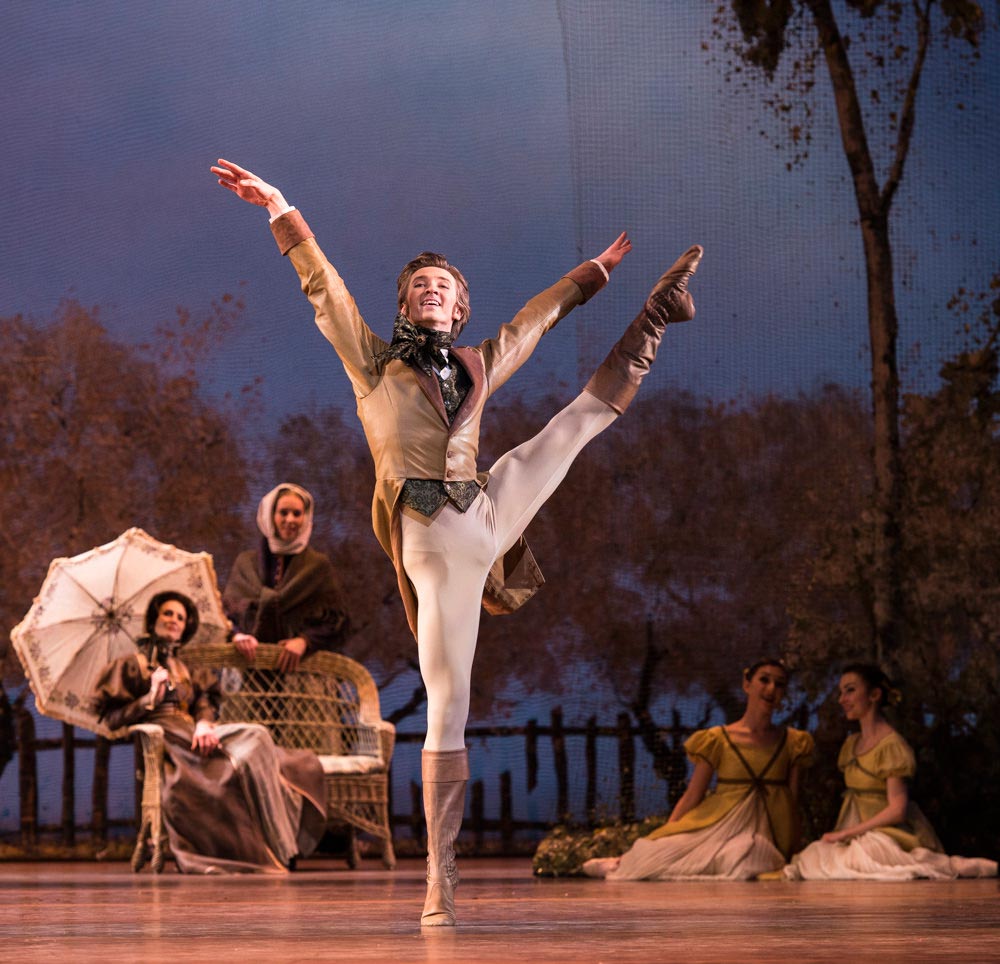
© Foteini Christofilopoulou, courtesy the Royal Opera House. (Click image for larger version)
I wish I could be as enthusiastic about Akane Takada’s Olga, the forth main player in the story. Indeed Takada is a superbly refined dancer but she did not look at all au fait with the interpretative demands of her part. Pity, for her lack of dramatic involvement detracted considerably from some of the more poignant moments. As for the rest of the company, it was great to see that the older characters in the first ballroom scene were not overplayed as seemed to have come customary in recent years, and that the corps were in splendid form – even though still not fully able to sparkle in the diagonal of grand jetés that concludes the first scene.














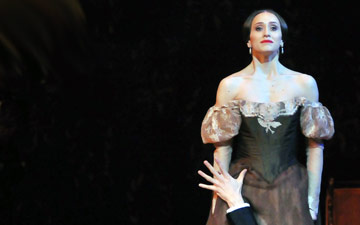
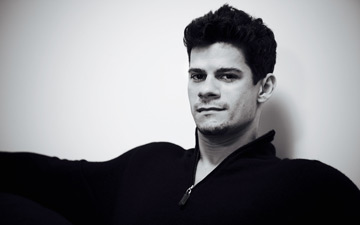
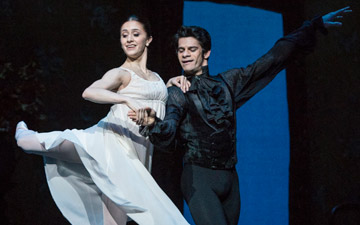
You must be logged in to post a comment.